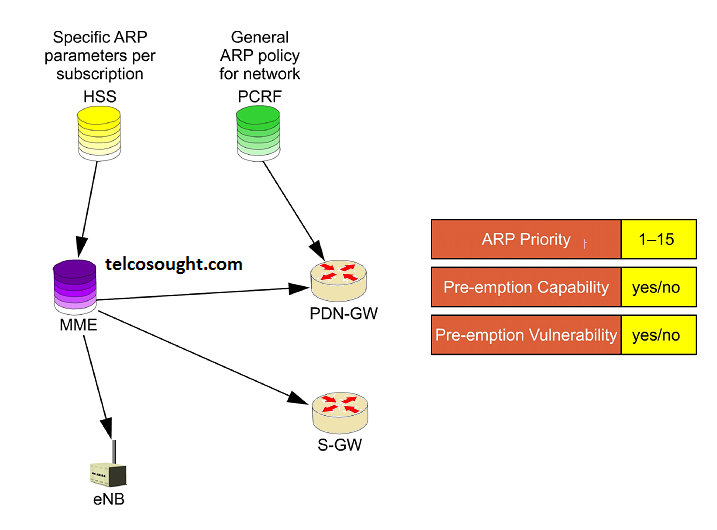In this 4G Lte article, we learn about the 4G Lte APR and QoS Levels. APR ( Allocation and Retention Priority ) protocol and QoS Levels in 4g LTE. so we discuss the two-point APR and QoS Levels. The EPS ARP facility allows the system to deal with overloaded and busy periods. In 4G Lte arp protocol times of high demand, in which there is a lot of competition for scarce resources The EPC will determine which of the competing EPS bearer requests are verified based on the ARP of the service sought.
The QoS Levels of the EPC are currently defined using the three levels GBR MBR, and AMBR (Aggregate Maximum Bit Rate). GBR connections have an unrestricted data rate which makes them suitable for carrying specific types of delay-sensitive and real-time traffic
- What is 4g LTE APR?
- What are QoS Levels
- What is 4G Lte arp protocol?
Table of Contents
4G Lte APR and QoS Levels
ARP (Allocation and Retention Priority)
The EPS ARP facility allows the system to deal with overloaded and busy periods. Every QoS class is linked with an ARP level, that determines the relative importance for the EPS bearers based on the classes.
There are fifteen levels of ARP that range between Priority 1 (highest) up to Priority 15 (lowest).
The other elements of ARP are merely “yes” or “no” parameters: the connection’s Pre-emption Capability, which determines the possibility of being capable of preempting other low-priority connections as well as Pre-emption Vulnerability that determines if it is able to be protected from higher-priority connections.
4G Lte arp protocol
In 4G Lte arp protocol times of high demand, in which there is a lot of competition for scarce resources The EPC will determine which of the competing EPS bearer requests are verified based on the ARP of the service sought. Bearers with higher Priority for ARP will be determined while those with a lower ARP priority are rejected. In case of overload, the EPC will consider the ARP levels of the existing bearers to decide which bearers are able to be eliminated Bearers who have EPS with low ARPs are first eliminated.
ARP has no impact on the forwarding of packets or prioritization decision-making inside EPC nodes, where the decisions are based on the bearer’s QCI, or within the transport network of IP, in which these considerations are managed through DiffServ (Differentiated Services).
4G LTE QoS Levels
The QoS Levels of the EPC is currently defined using the three levels GBR MBR, and AMBR (Aggregate Maximum Bit Rate).
GBR connections have an unrestricted data rate which makes them suitable for carrying specific types of delay-sensitive and real-time traffic. MBR connections are not guaranteed, variable-bit rate services that have a predetermined max data rate. If a connection’s rate exceeds the maximum set, the network could decide to stop removing the traffic that is not being used.
The parameters for GBR and MBR can be applied to a per bearer’ basis. AMBR can be applied to set of bearers. More specifically, an ensemble of bearers who aren’t GBR who end up at exactly the same UE. AMBR permits the EPS to define the maximum amount of bits per second for the entire group of bearers, which can later be distributed among the bearers.
The APN-AMBR parameter defines an agreed-upon bit rate that is available to non-GBR bearers who are connected to identical APN and therefore can be interpreted to apply on a per PCS basis. The UE AMBR parameter aggregates all bearers that are not that are associated with a single UE.
The designated bearers can be established by establishing them as GBR and non-GBR (i.e. MBR) according to the needs. The default bearers due to the possible need to alter their bandwidth once an initial attachment has been made and is not a GBR.
QoS packet scheduler
QoS router
QoS mqtt
arp protocol

